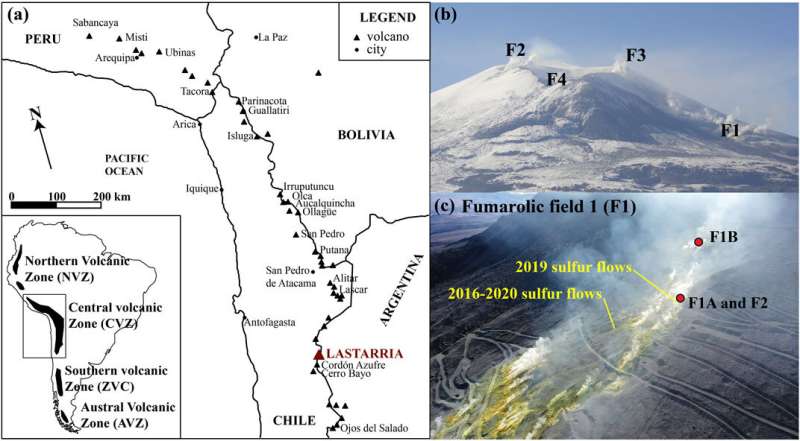Volcanic sulfur flows observed and recorded in northern Chile

A small international team of vulcanologists has observed a rarely seen event—a sulfur flow from a volcano—in northern Chile. In their paper published in the journal Frontiers in Earth Science, the group describes how they happened to observe the flow and what they learned about it as they studied its properties.
The image of molten rock flowing down the side of a volcano is a common sight, it is usually what happens when a volcano erupts. Less common are sulfur flows. Such flows, as their name implies, are a form of molten sulfur, which can, like molten rock, be pushed from the innards of an erupting volcano. Sulfur flows are far less dramatic, and the amount of flow material, the distance they flow and their temperature are all far less than what is seen with rock. Also, they happen far less often.
In this new work, the research team just happened to be studying satellite images of the Lastarria volcano, high up in the Andes near Chile's border with Argentina. After spotting evidence of what appeared to be a sulfur flow they ventured to the area and studied what they found.
At the site, the team found three independent sulfur flows, running nearly in parallel. They set up video recorders capturing the action as they went about measuring the flow. They also collected samples, which they brought back to their lab for study.
The researchers found that the longest of the flows was approximately 55 meters. All three were also much cooler than molten rock flows, averaging just 120°C to 150°C. They point out that sulfur melts at 119°C, which they note, could be a hint helping to explain why such flows occur.
The group found a lot of other material mixed in with the sulfur, mostly in very small amounts, such as uranium, lithium, arsenic, and niobium. The team also noticed that the flows were coming from cracks on the side of the volcano, perhaps another clue to their release.
They suggest that other hotter gases passing through the cracks melted the sulfur, allowing it to flow. They also note that Lastarria has not erupted since 2019–2020 but there have been signs of inflation, perhaps portending an eruption. If so, they consider the possibility of the appearance of a sulfur flow as a secondary sign of an impending eruption.
More information: Manuel Inostroza et al, Physical and chemical characteristics of active sulfur flows observed at Lastarria volcano (northern Chile) in January 2019, Frontiers in Earth Science (2023). DOI: 10.3389/feart.2023.1197363
No comments:
Post a Comment